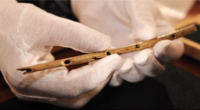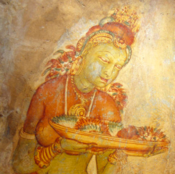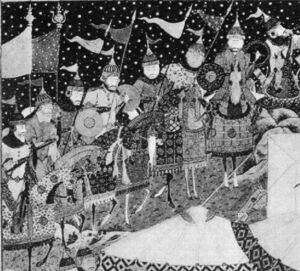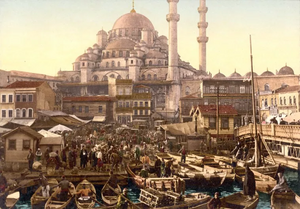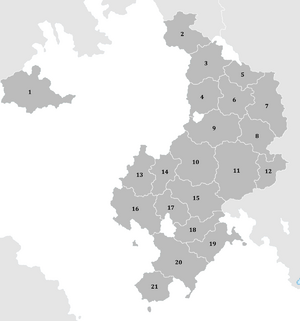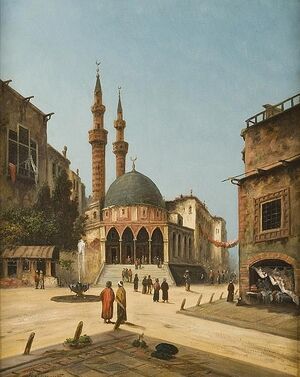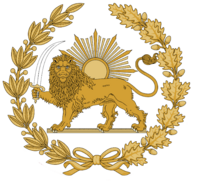Qal'eh
This article is incomplete because it is pending further input from participants, or it is a work-in-progress by one author. Please comment on this article's talk page to share your input, comments and questions. Note: To contribute to this article, you may need to seek help from the author(s) of this page. |
The Sublime State of Qal'eh دولتی الییه قلعه Dolate Eliyye Qal'eh | |
|---|---|
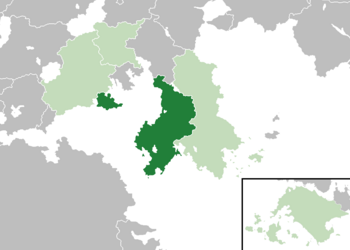 Location of Qal'eh (dark green) – in Sifhar (green and dark grey) – in the Universal Irsadic Cooperative Congress (green) | |
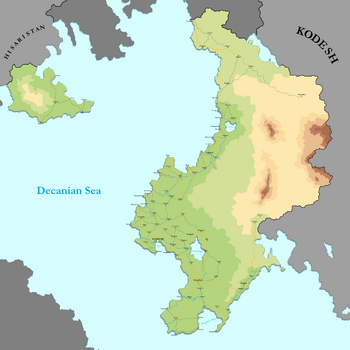 Map of Qal'eh (larger version) | |
| Capital | Dahrzor |
| Largest city | Kyderabad |
| Official languages | Qalehi |
| Ethnic groups | 74.2% Qalehis 15.6% Arvians 3.2% Dehqanis 2.2% Uruqs 1.9% Omurans 2.9% Other |
| Religion | State religion: Irsad (Malufi) Recognised minorities: Irsad (Rafada, Muadhi) |
| Demonym(s) | Qalehi |
| Government | Absolute monarchy |
| Ahmad Rouhani | |
• Crown Prince | Amir Reza Rouhani |
| Assembly of Qalehis | |
| Irsadic Assembly of the Peoples of Qal'eh | |
| Establishment | |
• Ardashirvan Empire | 476 BC |
• Haydarid Caliphate | 806 |
• Khutsog Khanate | 902 |
• Assadian Caliphate | 1026 |
• Qalehi Civil War | 1896 - 1901 |
• Monarchy re-established | April 18, 1901 |
• Current constitution | April 15, 1902 |
• 1989 Decree | November 17, 1989 |
| Area | |
• Total | 569,499 km2 (219,885 sq mi) |
| Population | |
• 2019 estimate | 58,753,012 |
• 2013 census | 52,981,727 |
• Density | 93.03/km2 (240.9/sq mi) |
| GDP (PPP) | 2019 estimate |
• Total | $891,165,686,016 |
• Per capita | $15,168 |
| GDP (nominal) | 2019 estimate |
• Total | $778,829,927,072 |
• Per capita | $13,256 |
| Gini (2015) | high |
| HDI (2015) | high |
| Currency | Qalehi Zaar (QLZ) |
| Date format | dd-mm-yyyy (official) |
| Driving side | left |
| Calling code | +872 |
| Internet TLD | .ql |
The Sublime State of Qal'eh, commonly known as simply Qal'eh or newrickised as Qaleh, Qalea or Qala and mydracised as Qalée (Qalehi: قله Qāleh [kæleh]) is a country in Western Catai. With almost 53 million inhabitants, Qal'eh is the 20th most populous country in Aeia. Comprising a land area of 569,499km², Qal'eh is one of the largest nations in its region. It borders Kodesh to the east and Hisaristan to the west through the Kasahgan Peninsula.
Qal'eh was first conquered by the expansive Ardashirvan Empire in 476 BC, who destroyed many ancient relics of the tribes of Qal'eh following their conquest, while simultaneously assimilating the culture of the tribesman into a more widely-accepted culture throughout the Empire. Many modern Qalehi traditions can have their roots traced back to the Ardashirvan Empire and the culture of the nation is heavily influenced by the conquest. The region broke away from the Ardashirvan Empire as many small successor states after a mutiny in the 4th century BC caused the army and many minorities within the empire to revolt, eventually leading to its demise. Qal'eh would be plunged into nearly a thousand years of various successor states and small kingdoms until it was conquered by the Haydarid Caliphate around 806 CE. The caliphate introduced Irsad from Hisaristan to Qal'eh. The Caliphate was invaded by Sükhbaataryn tribes in the 10th century CE, and in 902 the Khutsog Khanate was proclaimed. The Khanate dissolved due to internal instability a hundred years later, and fractured into many successor states. The largest successor state, Assadia, led by Muridin Emir Imrah I, reconquered the shattered realm between 1024 and 1026 in a series of conflicts now known as Imrah's Conquests. Modern-day Qal'eh unified around 200 years after the Assadian Caliphate ceased to exist in 1617, when Shahanshah Amin Rouhani unified the two main states that dominated Qal'eh, the first of to bear the title in the region for almost a thousand years. Qal'eh would undergo a civil war between monarchists loyal to the Shah and Qalehi republicans, which would end in 1902 and lead to the ratification of the 1902 Constitution, which still holds supreme law in the region. It is a controversial topic in Qal'eh, and its lawfulness is debated due to its age.
The sovereign state of Qal'eh is a minor-to-middle regional power in Catai, and enjoys good relations with its neighbour, Kodesh, mainly due to the fact that both nations follow the Malufi sect of Irsad.
Qal'eh enjoys rich cultural history, with many historic relics of tribes, the Ardashirvan Empire and the Assadian Caliphate adorning the country's museums and displays. The "Qalehi Renaissance" introduced exquisite art to the region, taking on board the techniques of many influential Asuran painters and sculptors.
Etymology
Qal'eh comes from Ardashirvani for "the Summit", supposedly named when one of its Shahs viewed the Decanian Sea from Mt. Asfak. The name derives directly from the Ardashirvani Kala (literally "high place"), the name also shares a similar etymology with the Kodeshi capital city, Qalah. Qal'eh has many international exonyms, and is usually newrickised as Qalea, Qaleh or Qala, although the government of Qal'eh prefers it to be referred to by its official endonym.
There are debates as to whether to etymology of Qal'eh actually comes from the old language of the Qi'nakhash kingdom, known as Bnatqa. Early evidence of the land referred to as a name whose derivative of Qal'eh exist in ancient relics of the Qi'nakhash kingdom, and the name may be a portmanteau of qal (expansive; big; large) and eh'la (green; fertile) - describing the fertile valleys and riverlands of southern Qal'eh. The name was first seen in ancient Qinaskhahi stories and ballads, written in the Bnatqa language.
History
Prehistory
Early evidence of human migration to Qal'eh suggests that mankind migrated to Qal'eh from Arabekh, and through Sifhar before eventually settling in modern-day Qal'eh. These neanderthal peoples of the paleolithic era were distinguished by their ability to create many complex tools and utilities using stone and wood. Early evidence of weaponry such as daggers and knives, small swords and axes have all been found during archaeological excavations in Qal'eh. One of the more prominent tribes in the area were known as the Paleo-Kalis, and occupied a lot of the southern coast, including the site of Kyderabad today. The Paleo-Kalis also contributed to the first culturally-significant artifacts in Qal'eh. Cave paintings and instruments were widespread throughout the lands occupied by the Paleo-Kali peoples, some of the more notable discoveries include the Chigir Cave Paintings, discovered and first documented in the early 18th century, and the Flute of Akhir, which was unearthed in 1997 during an archaeological dig near the town of Akhir. The flute has provided historians with some insight as to the traditions of early-to-mid Paleo-Kali society, and experts believe the flute to be around 40,000 years old - one of the first instruments of its type to be discovered in Aeia.
Civilised peoples have walked the lands that are now Qal'eh since around 1500 BC, with many small emirates, sheikhdoms and kingdoms occupying the lands for well over three millennia. Some of the earliest Qalehi civilisation's relics still exist today, such as walls and small buildings, although these are concentrated to the southern regions of Qal'eh, with civilisation that old yet to be discovered in northern Qal'eh. These civilisations also practised many cultural traditions, such as music, art and architectural crafts. It is believed that the early kings of Qi'nakhash, an ancient kingdom in the south of Qal'eh, played music as cultural gifts to the gods of the Qinakhashi pantheon, and the Khi'wa Mad'rasha ("White Hymn") is one of the world's oldest known pieces of music, discovered near Yulqunlu in 1920 and transliterated from cuneiform in 1934. The Khi'wa Mad'rasha is believed to be the start of Qalehi music as a whole, and a large influence for the nation's Korab folk music, music that is still used widely to this day.
Ardashirvan Empire
Many scattered nations occupied the land for that time period, but first major conquest came in 476 BC when the Ardashirvan Empire conquered Qal'eh in multiple wars between 481 and 476 BC. The Ardashirvan Empire is an influential ancestor to the modern state of Qal'eh, and contributed many aspects of its culture to the land, forms of Ardashirvani society, such as the Ardashirvani language and art customs are still extremely obvious and prevalent in modern-day Qal'eh - the nation's language, Qalehi, descends from the ancient Ardashirvani langauge.
During the reign of the Ardashirvan Empire, traditional Qalehi cultures, especially that of the Qi'nakhash Kingdom, were eventually rooted out - often by force. The pantheon of the Qinakhasi gods and various hymns and prayers written in the Bnatqa language were replaced with Ardashirvani prayers and hymns from the Mazdayasna religion. Due to the scattering of the pantheon and the ambiguity and uncertainty of the religion's gods, beliefs and followers in general, the Qinakhashi pantheon quickly became defunct in Qal'eh, with most of its old followers either converting to the Mazdayasna faith of the empire or being executed under charges of heresy. It was shortly after the Mazdayasna conversions that influential religious preacher and philosopher Zartosht was born.
Qalehi society gradually became more similar to that of the empire, and for around 400 years, the region was stable. There were some small revolts following the conquest, but none of which posed any threat to the expansive empire. The southern coast of Qal'eh especially began to flourish, as the Ardashirvan's rule in Qal'eh was centralised to the south. Its fertile and arable land, as well as exotic fruits with the potential for large crop harvests meant that the Ardashirvanis regularly developed the area, and held it in high priority. The imbalance of development introduced by the Ardashirvan Empire still shows today, with most of the Qalehi population situated in the south and south-central areas of Qal'eh.
It was around the 4th century BC when major revolts across the empire erupted following a mutiny in the Ardashirvan Empire after the Shah refused to pay their wages, due to an ongoing economic crisis throughout the empire. The crisis, revolts and mutiny eventually led to the demise of the Empire and the last of the Ardashirvani forces were expelled from Qal'eh in the 315 BC Battle of Esman. The swift exit of the empire from the region led to a large power struggle being created, and the lands once ruled by Ardashirvan were split into many large successor states.
Haydarid Caliphate
The Haydarid Caliphate began to pose a major threat to the Qalehi states throughout the 8th century CE, during which time it had conquered most of modern-day Hisaristan and Fahran. The Caliphate quickly expanded north into modern-day Dayganistan and by the start of the 9th century BC it had reached the borders of the northern states of Qal'eh. The Haydarids were the first Sifhar-wide empire to adhere to the Irsadic faith, and was first Irsadic country to border Qal'eh - which at this time still followed the Mazdayasna faith from the Ardashirvan Empire.
The Caliphate invaded in the year 803, claiming all lands it invaded for the Irsad faith and forcefully converting many traditional Mazdayasna followers to Irsad. The power struggle in Qal'eh was still ongoing at this time, which allowed the Haydarids to pick off and swiftly defeat the small, scattered armies of the states. The conquest was brutal, with as many as 150,000 lives estimated to have been taken in the conquests of the Haydarids. Haydarid battle experience from its previous conquests in Fahran, Hisaristan and Dayganistan also meant that their armies were more organised, more experienced and more disciplined that their Qalehi counterparts.
By 804, the Haydarids had invaded and annexed lands as far south as Lake Qori, and most of the fragile northern regions of Qal'eh had proclaimed their conversions to Irsad, mainly due to the fact that the Mazdayasna faith was concentrated in the south of the region, with many northern peoples following old pantheons of ancient kingdoms, and some even being irreligious. They continued their advance south, sieging the ancient and important port cities of the Qol-e and Chah Maku regions. Dashtu, Rahimabad and Astari were all sieged and breached in late-804 to early-805. The fall of these cities marked the end of the north's resistance to the invasion.
The bulk of the casualties in the invasion came from the southern emirates and sultanates, with the Haydarids easily and brutally advancing through the lucrative southern Qal'eh. The invasions came to close in 806 when the last bastions of Qalehi resistance were defeated near the modern-day city of Arzet. After the invasions, many of the Emirs and Sultans who resisted the invasion were sentenced to death, these executions would be the first time that stoning had occurred as an execution method in Qal'eh.
Many of the followers of the Mazdayasna faith were forcefully converted in the south, with many ancient temples and shrines dedicated to the religion vandalised and often destroyed. Those who would not convert were either killed or banished from the region, although evidence also exists that some religious resistors were taken out to the Decanian Sea, had rocks or other heavy objects strapped to their feet and dropped into the ocean. The practise gave way for the often-used Qalehi nickname for the sea - the "Sea of Bones". Irsadic places of worship were quickly erected throughout Qal'eh, and after around a century of rule, most of the Qalehi populace were adherents to the Irsadic faith - with Mazdayasna followers either living in hiding or renouncing their faith entirely. The forceful practises to purge Mazdayasna from Qal'eh by the Haydarids is the main reason as to why the Mazdayasna faith is such a small minority in Qal'eh today.
Khutsog Khanate
At the very beginning of the 10th century CE, much of Catai was subject to invasion from Turkic and Mongol tribes from the East, and Qal'eh was not an exception to this. The precision and speed of the militaries of these tribes allowed them to swiftly invade borderlands of the Haydarid Caliphate, which by the 9th and 10th centuries was a dwindling power, with regions far from the centralised government of the Caliphate breaking away. In 902 CE the Turkic/Mongol tribes invaded the Caliphate from the east, capitalising on the Haydarids' inability to cope with the increasing instability throughout the empire. With the Haydarids attempting resistance in the northern deserts and dry plains, their counter-invasion was ultimately unsuccessful and they were decisively defeated near Chah Kheyr by the future Bedes Khan. The war following the failed counter-invasion was quick, and after the Haydarid lines at Chah Kheyr had been broken through, the rest of Qal'eh was soon subjugated. In the same year, the Khutsog Khanate was proclaimed, which covered most of modern day Qal'eh as well as some minor borderlands in Kodesh.
The Khanate suffered from drastic internal stability problems due to the overwhelming majority Qalehi population, who had different traditions to the Turkic tribes from eastern Catai and Yidao. The Khanate is notorious for having many high-ranking officials assassinated while patrolling through major cities - and it became quickly obvious to the leaders of Khutsog that attempting to keep a strong grip over the region was futile. After the assassination of Tutei Khan in 976 CE, the first open Qalehi rebellion against the Khanate began, centred mainly in Dahrzor, although similar rebellions were staged in Kyderabad and Chigir. The rebellion ultimately failed and many of the rebel leaders were publicly executed by the Khanate, but it marked an important point in Qalehi resistance to the Khanate, and was seen as a morale boost for the native populace, who, despite losing the rebellion, had managed to fatally wound many influential governors within the Khanate.
The reign of Jegu Khan saw a rampant increase in instability and destabilisation, caused mainly by his ineffective rule over the region. By the beginning of the 11th century, much of the Khutsog's south-eastern and northern territories had broken away, with little resistance from the Khanate itself. When Jegu Khan's 25-year tenure had concluded, the Khanate had lost over half of the territory it owned when he ascended to the throne, and the increasing power struggle in the regions far from the government in Dahrzor led to increasing rebellious sentiment among the Qalehi sultans and warlords. Jamugha Khan's reign was comparable to his father's, with the inability to reign in the autonomous lands in the north and central parts of Qal'eh, the Khanate eventually suffered from internal rebellions and political strife. Jemugha fled Dahrzor in 1010 for the eastern city of Chigir, situated to the east of Lake Chigir, an important strategic stronghold for the Khanate. The Qalehi people led the three-year Siege of Dahrzor, with the capital eventually falling and moving to Chigir in 1013, various successor states had by now formed in the remnants of the once-great empire. Jemugha Khan continued to rule over what few lands he had left from Chigir, until he was murdered by his brother in 1017, who refused the throne of Khutsog and declared the Khanate defunct the same year. Some tribes loyal to Khutsog remained as insurgents, but the last of these tribes were expelled from Qal'eh by the end of 1019.
The Khutsog Khanate contributed little to Qalehi culture and society, although its military prowess proved to be useful to many of the leaders of the successor states that followed its downfall. With many aspects of Khutsog military, such as larger proportions of cavalry in armies, becoming commonplace in the military doctrines of the states. Few Khutsog monuments remain today, as most of them were destroyed following the Khanate's exit from Qal'eh - the ones that do remain are heavily damaged, with some being unrecognisable as monuments at all.
Assadian Caliphate
The Emirate of Assadia was one such successor state to the Haydarids, who were by now reigned back to western Sifhar. Assadia was confined to the southern regions of Kyderabad and Arzet, but they controlled much of the arable southern coast. Over the few short years that Assadia was at peace, its Emir, Imrah I, used these arable lands to grow large swathes of crops. On multiple occasions, he would sell these crops to other nations that bordered Assadia, to great economical benefit. The high income from the crop marketing allowed Imrah to field a large standing army, with historians estimating that in 1022 the army consisted of around 100,000 active troops. The large amount of crops being grown also allowed for the army to be consistently well-fed, which kept morale high in the camps, uncommon after the post-Haydarid economic depression that had encompassed many of the successor states.
Imrah also purchased two mercenary farmers based in the south, who had garnered a good reputation with previous conquests in the early-11th century. With a large standing-army (whose doctrine was influenced by the Khutsog Khanate - it fielded some 30,000 cavalry), and the two mercenary armies Imrah began to conquer the neighbouring states beginning in 1024. The beginning of Imrah's Conquests brought considerable benefits to the southern coast, starting a miniature golden age that would last the duration of the wars. Assadia's armies considerably outnumbered the armies of those who would rival them, and because of this the conquests were not met with any considerable resistance. The victims of the conquest often resorted to forceful conscription, and due to this their armies were largely demoralised, inexperienced and unorganised, which allowed for battles to be over quickly. The armies besieged Dahrzor for the second time in 15 years, and the city fell some months after. Similar sieges in Yulqunlu and Khazam Yek (1025), Sahlabad (1026) and Rahimabad (1027) were just as successful. In November 1027, the last resisting countries fell when Imrah personally led the Assadian armies to victory at the Battle of Mansur. Afterwards, he travelled back to Dahrzor and proclaimed the Assadian Caliphate, and proclaimed himself as the Caliph of the Assadids.
The Assadian Caliphate would continue the Haydarid traditions of forceful Irsadic conversions, and by the outbreak of the 12th century, most of Qal'eh were adherents of the faith. During the reign of Imrah, many Khutsog buildings and monuments were destroyed and replaced with other buildings more suited to the Qalehi populace and the Irsadic faith. The White Mosque was one such mosque built during this time, construction began in 1040 and the mosque was finished some time in 1206 (although it was completely renovated in 2000).
The Assadians had a long line of successful Caliphs after the death of Imrah in 1049, which continued the prosperity of the region and first introduced technology prevalent in the south to the northern regions of the Caliphate, something that the Haydarids neglected and failed to achieve. The cities of Tavresh and Chah Kheyr were founded as large fortresses on the rough borders of the Caliphate by Caliph Imrah III in the 12th century. Chah Kheyr became extremely advanced for its position in the desert and the population grew quickly due to both Assadian relocation programs as well the hope of new jobs, wealth and land. Roads were constructed to Chah Kheyr and the city quickly became an important outlying city for the Caliphate, and throughout the 12th and 13th centuries Chah Kheyr was the largest fortress in the Caliphate outside of the capital, Dahrzor. The roads constructed to Chah Kheyr often led invading forces towards the city, as it was difficult to traverse the arid desert terrain of the northern regions. When the Caliphate was invaded in 1357, besiegers took the city of Tavresh and took the large road to Chah Kheyr. Attrition, starvation and dehydration were commonplace for invading armies and the long passage became colloquially known as the "Road of a Thousand Corpses".
Throughout the 15th and 16th centuries the Caliphate oversaw many reforms to implement Irsad official into many governmental institutions, spearheaded by Islamist Caliph Ummar VI, who was renowned for his ruthless religious persecution, and was the first leader in the region to persecute Sixer Kufri Arvians in the north. Ummar outlawed non-Muridin from participating in any form of the Assadian government and got rid of those he deemed unholy (around half of the government, at the time). In 1579, he was forcefully deposed from the throne in favour of his more lenient brother, Basham, who was crowned Caliph the same year. Caliph Basham was one of the first Caliphs of Assadia to introduce the idea of non-radical Irsadic beliefs, and supported many reforms that increased civil and religious freedoms in the Caliphate, and revoked the policies introduced by his predecessor Ummar, allowing most of the officials removed to regain their occupations.
When Basham died in 1601, many major landowners that he granted autonomy too began to break away from the now-decentralised government in Dahrzor. Including most of the northern regions, the fortress of Chah Kheyr, the mercantile cities of Dashtu, Rahimabad and Astari, and much of the eastern mountainous regions. The Caliphate entered a rapid state of downfall, and when Ummar VII took the throne in 1601, his mental state began to quickly deteriorate, often making brash decisions that affected the Caliphate negatively. Many open rebellions against the Caliphate emerged, and Ummar began increasingly secluded in his palace in Dahrzor, often leaving the running of the Caliphate to his advisors. By 1605, the Caliphate only controlled the lands directly surrounding Dahrzor, with Dahrzor beginning to be besieged by an alliance of rebels who were notorious for the burning of the Al-Rashid Palace in October 1605, when they fired burning tree trunks into the palace using catapults acquired from abandoned Assadian military outposts and camps. When the gates of Dahrzor fell in 1606, Ummar's advisors convinced him to abdicate the throne and surrender to the rebels. Ummar would be stoned to death in public in Dahrzor in 1607, thus marking the end of the 600-year-old empire.
Reunification
After the fall of the Assadian Caliphate, Qal'eh again fell into a period of fragmentation and infighting between the various states that had emerged from the Caliphate's demise. The two main players in the region were the Emirate of Lahaar in the north and the Sultanate of Tajabad in the south. The Emirate of Lahaar accelerated growth in the north by introducing widespread desert irrigation and agriculture. The Lahaari Navy was used was trade with other states in the west of Catai and even as far as the Asur Sea and Asura. The Emirs of Lahaar were known for their pacifism and reluctancy to enter armed conflict, and the economy and civilisation experienced rapid growth because of this. On the other side of Qal'eh, the Tajabadi Sultanate were using the wealth of the southern coast to fund their expansive conquests, similar to the way Emir Imrah did so 600 years before.
Tajabad and Lahaar would undergo a few minor skirmishes at the border as well as some disputes over land but both the countries only entered war once in 1757, which ended in a status quo ante bellum. Both the countries would focus on their respective regions and the era would be one of acceleration in Qal'eh, both scientifically and militarily. The introduction of Asuran philosophical principles as well as literature and art occurred during the era, including the birth of artist Taqi al-Jafir.
After the 1787 dynastic crisis in Lahaar, an Emir of the Rouhani dynasty, the ruling dynasty of the Tajabadi Sultanate, was selected to ascend to the throne. The similar dynasties would ultimately result in bonding between Lahaar and Tajabad, and they entered an official diplomatic alliance in the 1789 Arzet Accords, which ensured stability in the region. In 1796, Sultan Mubashir Rouhani of Tajabad died, leaving succession to the Emir of Lahaar, and the two countries entered royal union in the same year. Emir Amin Rouhani succeeded to the throne of Lahaar in 1800, and worked to consolidate the power between the two sultanates, as well as subjugating the other smaller states in the Qal'eh region. During his short reign as Emir of Lahaar, Amin Rouhani brought the two countries closer together, not just through act of union, but through the relationship and trust the nations had in each other. In 1802, Amin travelled to Dahrzor and invited all minor leaders of the states around him. On March 18, 1802, Amin Rouhani proclaimed the Sublime State of Qal'eh to a crowd of 70,000 that had gathered in Dahrzor, the unification was met with resounding cheers and success in the following years of his reign. Amin consolidated the Rouhani dynasty and allowed it to flourish within the nation, becoming an extremely power dynasty under his reign. Amin's son, Omid Yazdan Rouhani, is unanimously regarded as the greatest Shahanshah in Qalehi history, reigning for over 46 years and turning Qal'eh from a secluded state to a large power in Sifhar, and introducing many reforms that greatly benefited the populace, especially poorer, working-class citizens. Omid Yazdan introduced the first example of costless healthcare for workers with high-risk jobs and consecrated the White Mosque in 1855. During the reign of Hossein Karim Rouhani, the Kasahgan Peninsula was acquired from the Veleaz via purchase.
Civil War
Tension between the Arvians in the north and Qalehis in the south had existed for a long time, and the uneven development of the regions only amplified this tension further. The Arvians felt as if they were unrepresented by the Shahanshah and the government of Qal'eh, and that their needs were being neglected. Following the Arvian Famine in 1877, many Arvians called for widespread reforms in the region, including that of a devolved government to best serve the interests of the region. Discrimination of Arvians living in the south increased after the famine, and the government's response to it. One such Arvian was revolutionary general Ghazaros Tufenkian, who, because of this widespread discrimination within the army, was discharged in 1894, and moved back to his hometown of Habudan.
Tufenkian was extremely influential in the gathering of Arvian nationalists, communists and revolutionaries in the 1895 Davakyan Conference, where the motion for an independent Arvian nation was tabled and agreed upon. Tufenkian wrote most of the Arvirestani Declaration of Independence, a document whose location is unknown, which outlined the secession of an Arvian republic from the State of Qal'eh. The Declaration went into effect on March 10, 1896, and the Republic of Arvirestan was declared, with Tufenkian as its interim President. The Arvirestani army consisted mainly of poorly-trained conscripts and guerrilla fighters, and never actually invaded Qal'eh, but preferred to take a defensive stance, to protect its independence, rather than to expand its power.
Arvirestan found little success in securing alliances abroad, with Tufenkian unable to make any meaningful alliances that would help them in the war. By 1897, the foreign efforts were stopped, and Tufenkian instead focused on recruiting more Arvian guerrillas and militias to fight for their cause.
Diplomatic warfare and stalemates were commonplace in the first months of the war, with neither of the belligerents willing to risk making an advance into enemy territory. The war employed many tactics seen during the Great War in Asura, the most notable of which being large-scale trench war as well as chemical and gas attacks. These trenches adorned the grassy borders of the two nations for around eight months, until November 1896, where the Qalehi forces scored a major victory over the Arvian militias in the Battle of Astari, pushing them back from the established trench lines and disorganising the main infantry greatly. A week after the Battle of Astari, the Qalehi forces had pushed two large Arvian regiments (totalling some 30-40,000 troops) to the banks of Lake Qori, where the regiments were slaughtered and decisively defeated at the Battle of Lake Qori, disbanding both regiments and sending them into full retreat.
The Battles of Astari and Lake Qori set the tone for much of the war to come, with Qalehi victories now becoming more frequent, the Arvian ground forces became increasingly demoralised. By 1898, the Qalehis had pushed the Arvians to the outskirts of Rahimabad, the subsequent day, a regiment of 20,000 Arvian soldiers surrendered to the Qalehi 4th and 5th Armies, most of which were sent to concentration camps nearby and exterminated in the Arvian Genocide[2] and the commanders of the army executed for high treason.
The Qalehi armies stormed Habudan on April 18, 1901, which brought an official end to the civil war and the Arvirestani Republic. The day is celebrated today as Liberation Day throughout Qal'eh and is a national holiday. Tufenkian was never caught in Habudan, and it was later discovered that he had fled to and sought refuge in Sidi Synnia, where he remained until his death in 1950. The civil war would end up being one of the bloodiest conflicts ever fought on Qalehi soil, with as many as 350,000 casualties throughout the war, including those killed in prisoner-of-war camps on both sides.
Following the civil war, the Qalehi industrial revolution began as industry began to greatly expand during the rebuild efforts of Qal'eh after the war. In particular, Dahrzor and Kyderabad saw massive growths in industrial capacity and economic output. Both cities saw large amounts of migration from other, smaller cities throughout Qal'eh and the employment rates rose from around 76% in 1900 to 84% by 1910. Military industry was popular in Dahrzor, and today is still the industrial heartlands of the Qalehi military.
Modern Era
Due to the outbreak of the civil war and Arvirestan seceding from the nation, Qal'eh remained neutral in the First Great War. The neutrality from international conflict hindered Qalehi ability to progress in military innovation, and the weaponry of the military remained stagnant until the 1920s, where the first military breakthroughs began to happen domestically. The first experiments with air travel were conducted in 1919, and the technology was deemed fit for the military. In co-ordination with X, the first prototypes were rolled out in 1920, with the prototypes being able to achieve sustained flight for medium distances. The P-III Prototype achieved a successful, unimpeded flight from Rahimabad to Vardal, one of the first Sifhari aircrafts to cross the Decanian Sea successfully.
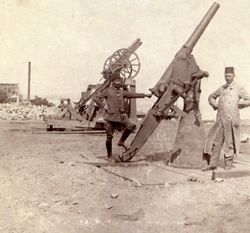
The development of this technology, however, was interrupted when Hisaristan invaded the Kasahgan Peninsula in 1920, beginning the Kasahgan War. Opinion of the war varied, and many military enthusiasts were skeptical of the war due to Qal'eh's lack of military innovation. Using the hilly terrain of the peninsula, the Kasahgan 1st Army managed to repel the Hisari invasion, and began a counter-invasion in January 1921. The Kasahgan 1st Army used knowledge of the terrain as well as guerrilla warfare tactics to repel the heavier units of the Hisari Empire. One of the leading tactics used in the first stages of the Kasahgan war were landmines, which often took out groups of Hisari soldiers as well as heavier cannons and artillery.
The Qalehi counter-invasion was successful initially, and the advancing forces took the cities of Khudakhona and Burzinshah during the invasion, after these initial successes, however, the Qalehi forces were met with Hisari resistance and a large stalemate. The stalemate remained until Dayganistan invaded Hisaristan and joined Qal'eh in November of 1921. This caused Hisari troops maintaining the stalemate near Burzinshah to be relocated to the Daygan front, which allowed the lines to be broken in mid-1922, this, paired with growing domestic instability in Hisaristan caused them to sue for peace in the Treaty of Ras Ar-Rashid, which provided Qal'eh with reparations for the war as well as a Hisari renunciation of their claim to the peninsula.
After the Kasahgan War, Qalehi military fervour was high, and the victory over Hisaristan was seen a great feat by the dwindling Qalehi military. Despite this, Qal'eh also remained neutral in the Second Great War, after which, the first Qalehi aircraft were rolled out, and the Royal Qalehi Air Force was created in 1939. The policies of isolationism and protectionism continued throughout the reigns of Nazeri Rouhani and Sadiq Ali Qassemi Rouhani, which allowed for increased funding for the further expansion of industry within the country. By the time Qassemi died in 1949, the country was fully modernised with a large industrial capacity. This modernisation encouraged Qassemi's successor, Fazel Vakili Rouhani, to seek closer relations with the emerging republics in Asura, and diplomatic relations missions began in 1951. During the 1950s and 1960s, various reforms and decrees were passed that granted the populace increased liberty as well as legalising secular beliefs and granting rights to followers of foreign religions (namely the Sixer Kufri Arvians in the north of Qal'eh). The reign of Farid Hashempour Rouhani saw much of the same reforms, with many of the laws passed during the Vakili era being protected and enhanced upon. In 1970, non-Muridin were permitted to hold established offices in the government and military and in 1973 Irsadic teachings were made optional in schools throughout the country. The reforms continued under Hossein Nemati Rouhani, whose short reign of almost seven years saw the introduction of single-payer universal healthcare, as well as many other reforms that decreased economic inequality. Hossein Nemati ensured that Qal'eh remained neutral in the Hisari Wars, and that support for one side was never expressed. When Ahmad Rouhani took the throne in 1984, these reforms were swiftly reversed and stricter, Irsadic ones were put in their place. Ahmad had been introduced to radical Irsadic beliefs by his uncle when he was a child, and had developed a distaste for the secular Qal'eh that had been emerging for the past thirty years. His reign is marked by the passing of the 1989 Decree, which declined various rights and liberties, as well as giving Qalehis priority in many things, including jobs and the military. In a response to the decree, the Arvian Summer uprisings began, a guerrilla campaign aimed at restoring the rights of the Arvian minority. The Shahanshah won the conflict and control over the north was cemented, as well as more rights declined and many high-ranking Arvians executed.
Since the end of the Arvian Summer in 1992, Qal'eh has not been involved in a military conflict, a trait that Ahmad Rouhani has said he wants to retain. The foreign relations of Qal'eh to Asuran nations were cut back severely in the late-1990s in favour of warmer relations with the nations of Sifhar. Military co-operation with nations such as Romellea have produced more advanced equipment for the Qalehi military, like the Azar II MBT. The nation has chased a position of isolationism from the rest of Aeia and has secluded itself from many foreign affairs. In 1996 the country joined the Universal Irsadic Cooperative Congress and in 1997 Qal'eh signed the Kizilkand Agreements, creating a customs union between itself, Fahran, Hisaristan, Romellea and Sidi Synnia (these countries were signatories in 1997, the agreements now include Habasha and Veleaz). The 2000s were a largely dormant era for Qal'eh, in which domestic development was slow, and international relations were stagnant. 2011 saw the creation of an exclusion zone around the seas of Habudan when Arvian revolts damaged the port, spilling chemicals and oil into the sea, the exclusion zone was not lifted in 2017 and it is perpetrators' fates are unknown.
Geography
Climate
The climate of Qal'eh consists of extremely hot and arid summers in the north and central regions, with little to no rain falling in the regions for most of the year. The southern coast of Qal'eh enjoys cooler summers and winters and more rainfall than its northern and central counterparts, with much of the region being covered in temperate forests, especially on the coasts of the Iranic Sea and Majulan Ocean.
Administrative Divisions
Qal'eh is divided into 21 provinces, each with its own governor personally appointed by the Shahanshah. Most of the more populous provinces, including the capital Dahrzor and largest city Kyderabad, are located in the south of the country.
Qal'eh has a high urban growth rate, with the urban population increasing from 55% to 62% between 2000 and 2017. It is predicted that by 2030, Qalehi urban population will succeed 75%. The country's largest city, Kyderabad, attracts around 150,000 migrants per year, and is an economic and cultural hub of Western Catai.
| Number on map | Province Name | Population | Number on Map | Province Name | Population |
|---|---|---|---|---|---|
| 1 | Kasahgan | 3,762,839 | 12 | Tudasht | 493,277 |
| 2 | Saremeh | 1,873,192 | 13 | Shemrabad | 2,026,883 |
| 3 | Malakeh | 1,916,283 | 14 | Mamdeh | 1,739,288 |
| 4 | Qol-e | 1,581,283 | 15 | Gonbaz | 2,028,772 |
| 5 | Ghazab | 209,812 | 16 | Greater Dahrzor | 6,434,719 |
| 6 | Kashkamir | 972,277 | 17 | Behesht | 2,023,889 |
| 7 | Yadabad | 1,482,662 | 18 | Qujd | 2,273,992 |
| 8 | Pawari | 892,039 | 19 | Kodyan | 3,019,837 |
| 9 | Chah Maku | 2,972,377 | 20 | Greater Kyderabad | 8,980,273 |
| 10 | Tajabad | 3,663,820 | 21 | Zarghari | 2,273,930 |
| 11 | Gur Nasab | 2,360,283 |
Major Cities
Largest cities and towns in Qal'eh
Royal Demographic Institution of Qal'eh | |||||||||
|---|---|---|---|---|---|---|---|---|---|
| Rank | Province | Pop. | Rank | Province | Pop. | ||||
 Kyderabad  Dahrzor |
1 | Kyderabad | Greater Kyderabad | 6,182,038 | 11 | Astari | Chah Maku | 512,938 |  Sahlabad  Sīraf |
| 2 | Dahrzor | Greater Dahrzor | 5,172,928 | 12 | Rezalakh | Kodyan | 497,038 | ||
| 3 | Sahlabad | Tajabad | 1,736,277 | 13 | Chah Kheyr | Yadabad | 461,663 | ||
| 4 | Sīraf | Mamdeh | 977,024 | 14 | Darabad | Kodyan | 382,546 | ||
| 5 | Vardāl | Kasahgan Peninsula | 812,546 | 15 | Posht | Kodyan | 381,377 | ||
| 6 | Arzet | Zarghari | 732,019 | 16 | Habudan | Saremeh | 320,736 | ||
| 7 | Rādez | Shemrabad | 681,564 | 17 | Shahdun | Greater Kyderabad | 282,431 | ||
| 8 | Dashtu | Qol-e | 612,692 | 18 | Chigir | Qujd | 231,290 | ||
| 9 | Senjeru | Malakeh | 604,918 | 19 | Farīmak | Gonbaz | 228,635 | ||
| 10 | Rahimabad | Chah Maku | 540,166 | 20 | Parvaz | Gonbaz | 212,938 | ||
Government and Politics
Qal'eh is an absolute monarchy, and has been since its foundation in 1802. Between 1802 and 1902, the Shahanshah had unlimited power throughout the Qalehi realm. However, after the 1902 constitution was ratified after the Qalehi Civil War, the Shahanshah's powers were somewhat limited.
Shahanshah
The Shahanshah is responsible for supervising (and in some cases, enacting) laws and policies throughout Qal'eh. The Shahanshah holds near-absolute power over the region as outlined in the 1902 Constitution. The Shahanshah also attends major foreign relations events as the representative of Qal'eh, but can assign diplomats in his stead, which is usually the case for smaller foreign visits. The Shahanshah acts as the official head-of-state of Qal'eh and is the Commander of the Qalehi Armed Forces.
Legislature
The legislature of Qal'eh, known as the Irsadic Assembly of the People's of Qal'eh or just the Irsadic Assembly, is a unicameral body consisting of 178 members, who are responsible for drafting laws, debating policies, ratifying treaties and some economic aspects of the country, including the annual budget. The Irsadic Assembly is also responsible for drafting amendments to the constitution. All laws that exit the Irsadic Assembly must be ratified by the Shahanshah. All candidates for the Irsadic Assembly require approval from the Assembly of Qalehis.

The Assembly of Qalehis consists of 10 field-specific experts, all appointed by the Shahanshah. The Assembly of Qalehis is responsible for interpreting the Constitution, and scrutinising laws passed by the Irsadic Assembly. If a law is deemed incompatible with the Consitution or the Iqar (Irsadic law), it is sent back to the Irsadic Assembly for revision. The Assembly of Qalehis is also responsible for supervising passed amendments to the 1902 Constitution, the last of which was in 1998. The Assembly of Qalehis may ignore amendments that failed to receive majority vote in the Irsadic Assembly, and must implement amendments that received over 95% of votes. The Assembly of Qalehis ultimately have the final decision if the amendment carried a majority of less than 95%.
Law
The Assembly of Qalehis appoint the Judiciary under the supervision of the Shahanshah. Court rulings can be appealed to the Assembly of Qalehis, although the legitimacy and impartiality of this appeal process is debated. Qalehi law comprises Iqar Law and other laws specific to the region. The Shahanshah may enact Royal Decrees with the consent of the Assembly of Qalehis, which have the full force of law. One notorious example is the 1989 Decree, which causes political turmoil in Qal'eh to this day.
Foreign Relations
Qalehi relations with most of Western Catai are stable, and the nation enjoys good relations with its neighbour, Kodesh, both of whom are Malufi absolute monarchies.
Military
Qal'eh has three branches that make up its military forces, the Army, Navy and Air Force. The Qalehi Armed Forces are made up 257,500 active troops, 71,000 of which are conscripts, and 391,000 reserve troops, totalling just under 650,000 trained troops.
Qal'eh spends just under $12 billion on its military, totalling 1.8% of its GDP or $225 per capita.
Economy
Agriculture
Much of the southern portion of Qal'eh consists of fertile and arable land, most notably in the Dahrzor and Kyderabad regions, where the two largest cities are located. The southern coast of Qal'eh is home to a number of exotic fruits, including a staple in Qalehi cuisine, the fig. While the northern portion of the country is mainly desert in the inland, the coastal regions are suitable for farming. As such, the government is investing in getting the northern regions up to par in terms of agriculture, with around $650 million invested for it in a plan announced in 2016.
Industry
The industrial heartlands of Qal'eh are also in the southern region of the country, with many of the country's larger cities being in the south due to industrial migration. Qalehi companies export and have operations in many Western Catai countries, with this only increasing after Qal'eh signed the Kizilkand Agreements in 1997.
Qal'eh has many automobile manufacturing companies, although most only work domestically. The capital province of Dahrzor contained around 40% of the country's industry in 2015, mainly private military industry selling equipment to the Qalehi Armed Forces. The industrial sector of Qal'eh employed around 37% of the population in the 2013 census and industry contributes to around 75% of the Qalehi GDP.
Natural Resources
Qal'eh is one of the largest natural gas and oil exporters in Western Catai, and much of the nation is powered by the two resources. Large fracking operations take place in the north-east of Qal'eh, where a large proven natural gas reserve was recently discovered, whereas oil extraction takes place mainly in the central regions of Qal'eh.
Education, science and technology
Qal'eh has a secondary school enrollment rate of over 99%, and attending school until 17 is enforced by the law. However this age is reduced to 16 if the student joins the military. Many prestigious universities in Qal'eh attract students from all over Western Catai, such as the Royal University of Kodyan. Qalehi levels of education are split into three fields, a secondary degree (derjh dewm), which is attained upon leaving high school at 17, a bachelor's degree (medrek keareshenasa), which is achieved for completing an undergraduate course and passing the undergraduate exam at a Qalehi university, and a master's degree (medrek keareshenasa areshed; also known as derjh nekhebguan) received upon completing the postgraduate course and passing the postgraduate exam at a Qalehi university. A master's degree is required to persue a doctorate (deketera) in Qal'eh.
The Qalehi science sector is not very large, and Qal'eh itself has not been responsible for many innovations throughout the 19th and 20th centuries. Many ancient inventions of the Ardashirvan Empire and the Assadian Caliphate were invented within Qal'eh, but they are often attributed to the empires themselves, rather than where they were made. Recently, however, Qal'eh has become an emergent nation in the fields of stem cell research and nanotechnology, with stem cell operations already present in many Qalehi hospitals and surgeries.
Demographics
| 1943-2013 | ||
|---|---|---|
| Year | Pop. | ±% p.a. |
| 1943 | 6,827,910 | — |
| 1953 | 12,637,982 | +6.35% |
| 1963 | 19,829,390 | +4.61% |
| 1973 | 25,729,993 | +2.64% |
| 1983 | 30,523,413 | +1.72% |
| 1993 | 36,720,188 | +1.87% |
| 2003 | 44,341,882 | +1.90% |
| 2013 | 52,981,727 | +1.80% |
Qal'eh is home to many differing ethnic groups, who are united under a shared Qalehi identity. The population of Qal'eh was 52,981,727 at the 2013 census, 74% of whom identified as Qalehi. Net migration has plateaued at around 310,000 for the past two decades, reaching its peak of 317,000 in 1999. Qal'eh is the 4th most populous country in Western Catai, falling behind Dayganistan (80 million), Kodesh (78.6 million) and Hisaristan (58.2 million). The population density of Qal'eh is Xkm² (Xmi²), with the population density being highest in Dahrzor and Kyderabad.
Languages
Qalehi is the main language of Qal'eh, with over 95% of the populace speaking it. Other languages are spoken throughout Qal'eh, including many minority dialects, but these other languages and dialects are often suppressed during education, as Qalehi is the only language taught in the curriculum. Due to this, the number of foreign language speakers in Qal'eh is declining.
Ethnic Groups
Ethnic Groups in Qal'eh (2016 est.)
Qal'eh is technically a very diverse region, but most of these differing minorities identify as Qalehi when asked. Qalehis are believed to be descended from the peoples of the Ardashirvan Empire, with many Qalehis also having ancestry from Eastern Catai from when the Khutsog Khanate ruled the region.
Ethnicites within Qal'eh remain a point of debate, with the omission of an ethnicity section in every census since 1993, ethnic boundaries and populations within the country are educated estimates. The general consensus is that around 74-75% are of Qalehi ethnicity and a further 15-20% are of Arvian ethnicity. Minorities from other ethno-linguistic backgrounds include Omurans from Kodesh and Uruqs from Uwhistan. Other minor ethnicities in Qal'eh make up around 3% of the population, which include people from Asuran background, as well as East and Far West Cataians.
The Royal Qalehi Demographics Institution, the branch of government tasked with arranging and estimating the demographics of the nation, estimate that some 90% of Qal'eh are of Qalehi background, but this estimate is widely believed by demographic experts to be biased and inaccurate.
Religion
Malufi Irsad is the official state religion, the status of which is widely enforced and influences important structures of Qalehi soceity such as law and the educational curriculum (Irsadic values are taught to children when they begin education). Under Qalehi law it is illegal to practice other religions in public, with the construction of other holy buildings such as churches forbidden. Qal'eh generally has a poor human rights record when it comes to religion.
In the 2013 census, around 95% of Qalehi citizens answered that they were Malufi Murudin, with the other 5% consisting of Rafada and Muadhi Muridin. The high majority of Muridin in Qal'eh make it one of the most religious nations in Aeia. Many Qalehi Muridin attend mosque services, with an estimated 25 million Qalehis visiting a mosque within the country daily.
Culture
Art
Qalehi art has a rich history, dating back to ancient tribal cave paintings in central Qal'eh, discovered some time in the 19th century, known as the Chigir Cave Paintings, named after the city they reside near. They are believed to have been painted around 1500 - 1000 BC, with some historians and art experts estimating they could even be as old as 2000 BC.
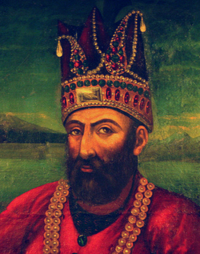
Qalehi art developed further while it was under the rule of the Ardashirvan Empire, and many detailed paintings of landscapes and portraits for its time emerged during this period. Qalehi art remained unchanged for a long period of time after Ardashirvan painting traditions were introduced. When Irsad was introduced into the region by the Haydarid Caliphate, many paintings of Allah and historic Irsadic figures such as Mubashir emerged, and Qalehi Irsadic paintings would continue to be produced throughout the era.
Throughout the 18th and 19th centuries, large changes in how Qalehi artists and sculptors made their work occurred. Largely influenced by their Asuran equivalents, new techniques of painting, as well as new topics of paintings, started circulating around Qal'eh. The period of time has come to be known as the "Qalehi Renaissance". The Qalehi Renaissance also introduced marble into the Qalehi sculpting world. The first known work of the Qalehi Renaissance was a painting entitled Zommari Mosque, by Taqi al-Jafir, an influential Qalehi Renaissance artist, architect and sculptor, which was painted in either 1771 or 1772.
Since then, Qalehi art has been at the forefront of West Cataian culture, and many influential historical leaders of Catai have chosen to have portraits painted by Qalehi artists. The Dahrzor Art Exhibition showcases art from all over Qal'eh, and convenes annually at the Omid Yazdan Centre in Dahrzor.
Architecture
Qalehi architecture is similar to its West Cataian counterparts, with many grand mosques adorning the landscape of Qal'eh. The two most famous mosques, the Zommari Mosque and Grand Mosque, both in Dahrzor, attract around 5 million worshippers per year.
The history of Qalehi architecture can be traced back to the Ardashirvan Empire, where many basic shrines and temples were constructed for the Mazdayasna faith of the empire. These temples were often constructed using rock and sandstone, and some of these holy sites still exist today, mainly in the southern coast of Qal'eh. The architecture in Qal'eh varies depending on the era it was built in. Obvious differences between pre and post-Irsadic architecture can be seen in many older buildings.
Evidence that mathematics and geometry were used in Qalehi architecture can be found from the Ardashirvan Empire, making it one of the first nations to do so. Some art experts in Qal'eh argue that its architecture is its proudest form of art.
Literature
The oldest evidence of Qalehi literature is an ancient transcription of the Mazdayasna holy text, the Avesta, found near the city of Kyderabad in an archaeological dig in the 1940s. The transcription of the text is said to date as far back as 200 BC, and was likely to have been used in many Mazdayasna ceremonies in southern Qal'eh. The author of the transcription is unknown, but it is widely agreed upon by historians to be the work of a Mazdayasnan cleric named Kiarash Tut, who was extremely influential in the religion of the region at the time.
Since then, many transcriptions of the Irsadic holy text, the Nashwad, have been transcribed in Qal'eh. Many old transcriptions from when the first Irsadic conquests occurred in around the 7th century still exist in museums around Qal'eh.
Modern Qalehi literature is somewhat stagnant, with no real influential non-religious literature originating in the nation. Qal'eh holds an annual literary festival in Chigir, in which domestic authors can come together to share and advertise their writing.
Philosophy
Zartosht, The Thesis of Religion
Qalehi has a rich history of philosophy and philosophical thought. The ancient Qalehi philosopher and prophet Zartosht (born c. 412 BC) introduced a wide range of philosophical thought into Qalehi (and Ardashirvan) society. He preached many widely accepted modern values today including religious tolerance and freedom of speech, and wrote many books on his thoughts. The most notorious of which, The Thesis of Religion, published around 385-370 BC, first introduced the ideas of religious tolerance and religious freedoms into mainstream Qalehi society. The original copy of Zartosht's Thesis is kept in the Royal Library of Dahrzor, where it continues to influence many modern philosophers around Aeia. Zartosht was also an avid follower of Mazdayasna, and regularly attended religious ceremonies and festivals.
Music
Qalehi music has existed since the 2nd century BC, where many early wind and string instruments were first developed and used. Zoroaster's Hymn is a famous piece of music composed around 50 BC which utilises many of these ancient wind and string instruments.
The music of Qal'eh began to develop drastically after the Irsadic conqeusts of the Haydarids in the 7th century and even more so after Imrah's Conquests stopped in 1026. Many developments in musical writing, notations and playing occurred in the early Irsadic times of Qal'eh. The nation's traditional folk music, Korab, originated in the 11th century, and is said to have been played to Sultan Imrah in Dashtu at a ceremony celebrating his conquests. Korab is still widely used today, and is played at many important events, including coronations, funerals and official diplomatic visits.
Observances
Public Holidays
Liberation Day is celebrated on April 18 to commemorate the royalist forces storming the gates of Dahrzor, the last republican stronghold, and ending the Qalehi Civil War.
Cuisine
Qalehi cuisine is very diverse due to the large number of differing ethnic groups and cultures within its borders. Many aspects of Qalehi cuisine make use of the fig, a national staple and widely grown fruit on the south coast. Many Qalehi patisseries are renowned for their fig jams. Tea is widely consumed in Qal'eh and is usually the focal point of many small meals.
Other staple Qalehi cuisines include falafel, stews and soups, kebabs and yoghurts.
Sports
The population of Qal'eh is quite young, and as such, many people in Qal'eh participate in an organised sport.
The most widely-played sport in Qal'eh is football with around a million active players in the country. The Qal'eh National League is the nation's top-tier football league. The Qal'eh national football team are a successful international team, winning many cups in Catai and Sifhar as well as winning the Copa d'Aeia in 1995, when it was hosted in Marensoald. The Qalehi national team has qualified for the Copa d'Aeia every year since its inauguration in 1990. Basketball is also extremely popular in Qal'eh, and the men's national team is extremely successful in international basketball exhibition matches.
The Royal Sporting Committee of Qal'eh was formed in 1967 and aimed to consolidate the many small sporting organisations of Qal'eh into one central organisation. The RSCQ is responsible for organising Qalehi athletes' participation in international sporting events, as well as acting as a central governing body for most Qalehi sport. One exception to this is the football team, which is governed by the National Football Federation of Qal'eh, or NFFQ, as it is commonly abbreviated.
Media
Qal'eh has poor press freedoms, with political dissidents and anti-Irsadic journalists and reporters being arrested and censored on numerous occasions. The government of Qal'eh is also known to apprehend many journalists who speak out against the government, with some never returning (assumed to have been killed).
The Royal Press Society regulates all press and media within Qal'eh, including TV news as well as magazines and newspapers. The first iterations of newspapers were circulated during the reign of Mohammed Mohsen Rouhani, when the Irsadic Qalehi Herald was introduced as the country's national newspaper in 1877. The IQH continues to be Qal'eh's largest newspaper printer and publisher.
Television in Qal'eh was introduced in 1961, and full colour broadcasts began in 1980. The National Broadcasting Service (NBS) has influence over most Qalehi radio, television and press. The NBS has been accused on numerous occasions of corruption and governmental meddling. It is almost certain that the NBS has ties to the government and the Shahanshah.
See also
- ↑ A quote generally associated to Omid Yazdan Rouhani Shah who ruled from 1818 to 1864, the saying is referred as to a "royal belief" in the 1902 Constitution and has been de facto adopted as the nation's motto.
- ↑ The Qalehi government continues to officially deny that an Arvian genocide ever happened, although evidence has been found in the region. Mentions of the event are suppressed within Qal'eh.


